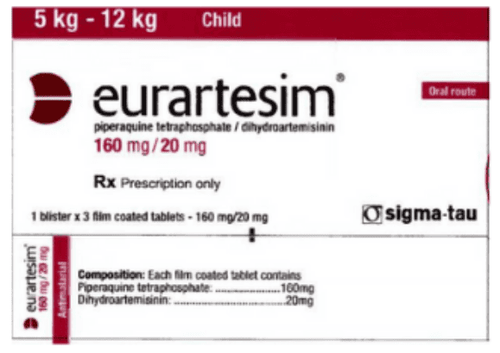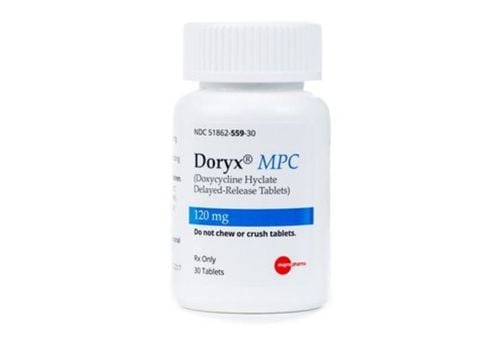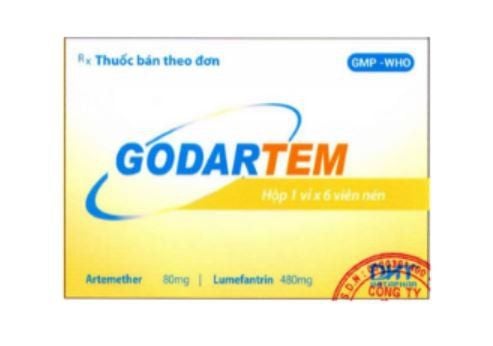This is an automatically translated article.
Komefan 140 is a combination of two drugs artemether and lumefantrine, Komefan 140 is on the World Health Organization's list of essential drugs and is used to treat malaria when the patient uses chloroquine without bringing it back. effective .1. What is Komefan 140?
Komefan 140 has the main ingredients Artemether 20mg and Lumefantrin 120mg, belonging to the group of drugs for parasites, anti-infectives, antivirals and antifungals. Komefan 140 is indicated for use in the treatment of common malaria cases caused by Plasmodium falciparum virus including severe malaria caused by strains of P. falciparum in adults, children and infants weighing 5 kg or more. above.2. Dosage and how to use the drug
2.1. How to use
The drug is produced in the form of tablets, used orally, in order for the drug to work best, the patient should take the drug while eating or drinking with milk to increase the absorption of the drug. In cases where the patient vomits 1 hour after taking the drug, repeat the dose of the drug used. The drug can be crushed to make it easy to swallow. The drug is produced in the form of tablets, used orally, to promote the best effect, the patient should take the drug while eating or drinking with milk to increase absorption. drug intake. In cases where the patient vomits 1 hour after taking the drug, repeat the dose of the drug used. The medicine can be crushed to make it easier to swallow.
2.2. Drug dosage
The dose of medication prescribed will depend on your weight and medical condition. The recommended dose by WHO is a total of 6 doses from baseline and repeated after 8, 24, 36, 48 and 60 hours. Specifically as follows:For adults and children weighing over 34kg use lumefantrin 480mg/artemether 80mg. Children from 5 to 14 kg use a dose of lumefantrin 120 mg / artemether 20 mg. Children from 15-24 kg use the dose of lumefantrin 240mg / artemether 40mg. Children from 25 - 34 kg use the dose of lumefantrin 360mg / artemether 60mg. For patients with renal and hepatic impairment: No dosage adjustment is necessary, but should be used with caution in patients with severe liver and kidney function problems. Elderly people can use the drug at the same dosage as normal people. Contraindications: Do not use the drug for people who are hypersensitive to lumefantrin or artemether or any of its ingredients.
3. Side effects
Causes arrhythmia with symptoms such as palpitations, prolongation of the QT interval (is one of the heart diseases when the heart's electrical system becomes abnormal). Causes nervous system disorders with manifestations such as headache, dizziness, paresthesia, abnormal gait, ataxia, decreased touch, drowsiness, convulsions. Respiratory disorders such as cough. Gastrointestinal disorders with symptoms such as lower abdominal pain, nausea, vomiting, diarrhea, loss of appetite. Tissue and subcutaneous disorders with manifestations such as rash, pruritus, urticaria, angioedema, arthralgia, muscle fatigue. Systemic and local reactions such as weakness and fatigue. Immune system disorders such as hypersensitivity reactions. Hepatobiliary disorders such as affecting liver function, this case often occurs in infants and children under 12 years of age, rarely in adults and children over 12 years old. Psychiatric disorders such as insomnia, sleep disturbances.4. Caution
During pregnancy: The drug should not be used in pregnant women during the first 3 months but should use other more suitable antimalarial measures. Although there are currently insufficient data on the use of artemether and lumefantrin in pregnancy, animal studies have shown that Komefan, as well as other artemisinin derivatives, affects the fetus and causes birth defects. when used during the first 3 months of pregnancy. Lactation: The components artemether, dihydroartememisinin and lumefangin are excreted in human milk very little. Therefore, breastfeeding women can use Komefan in the treatment of malaria. Do not use in patients with prolonged AQ range because Komefan may increase the risk of arrhythmias. Therefore, the drug should be avoided in patients with a history of congenital prolongation of the QT interval, a history of systemic arrhythmias, bradycardia or congestive heart failure. Do not use for patients with electrolyte imbalance disorders such as hypokalemia, hypomagnesemia. People who are using class IA, III antiarrhythmic drugs and some antidepressants, tranquilizers and some antibiotics such as macrolides and fluoroquinolones. Do not use the drug in patients with liver and kidney dysfunction. The drug should not be used for patients with severe malaria: Komefan has not been evaluated effectively for patients with severe malaria such as cerebral malaria or other manifestations such as pulmonary edema, renal failure, patients with high levels of malaria parasites in the body. Do not use the drug in the prevention of malaria. Komefan should not be used in combination with other antimalarial drugs: Komefan should not be used in combination with any other antimalarial drug due to the lack of data demonstrating its safety and efficacy, except for in the absence of other treatment options. In case a patient uses Komefan but his condition does not improve and tends to worsen, an alternative treatment should be taken immediately. In these cases, it is necessary to follow the ICG and intervene when there is an electrolyte disturbance. If Komefan is used after using meffoquin, the patient should be closely monitored because it can cause side effects. For patients previously treated with halofantrin, Komelan should be started at least 1 month after the last dose of halofantrin. Effect on hormonal contraceptives: Komefan reduces the effectiveness of hormonal contraceptives. Therefore, the patient should use additional methods of contraception.5. Drug interactions
Interactions with other antimalarials: Komefan should not be used concurrently with other antimalarial drugs. In addition, other antimalarials tend to prolong the QT interval. Therefore, caution should be exercised when Komelan is used in patients who still have other antimalarial drug levels in the blood. Halolantrin: In patients previously treated with halolantrin, Komefan should be administered at least 1 month from the last dose of halofantrine due to the long half-life of halofamtrin and potential effects on the QT interval. Interactions with CYP450 enzymes: Human studies have shown that the artemisinin component has the potential to induce enzymes such as CYP3A4 and CYP2C19 and to inhibit CYP2D6, CYPTA2. Although the degree of change in the concentration of these enzymes is low, it can still affect the therapeutic effect or safety of the drug because Komefan 140 is metabolized mainly by these enzymes. Protease Inhibitors IIV: When co-administered with lopinavir, the AUC of lumefantrin was increased by 193% and the Cmax increased by 82%. Caution should therefore be exercised when co-administering Komefan and HIV protease inhibitors.Please dial HOTLINE for more information or register for an appointment HERE. Download MyVinmec app to make appointments faster and to manage your bookings easily.













